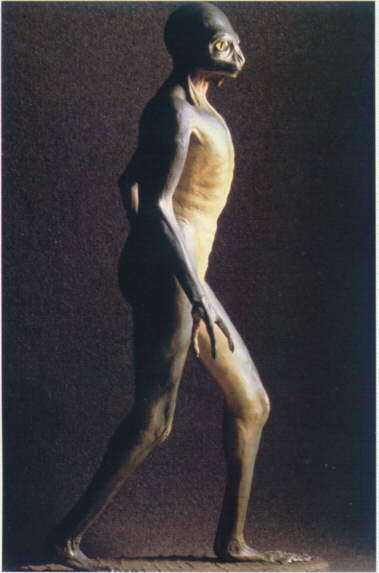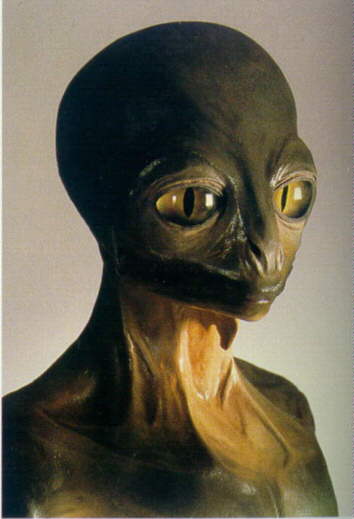

Excerpts from "Extraterrestrials - A field guide for Earthlings" by Terence Dickson & Adolf Schaller, Camden House 1994.
Suppose dinosaurs had not become extinct? While we can merely guess how extra-terrestrials might look, we have a hint of what intelligent life on Earth might have been like if the history of life on this planet had been changed just slightly.
What if dinosaurs had continued to evolve? Thatís what Dale Russell, a palaeontologist at the Canadian Museum of Nature, wondered. Russell theoretically extended the evolution of the most intelligent known dinosaur, a long-tailed forest dweller about five feet tall called Stenonychosaurus. This dinosaur was about the size of a kangaroo and lived 70 or 80 million years ago in what is now western Canada. It was the smartest dinosaur known, with a larger brain (compared with body weight) than that of any other animal on Earth.
After forecasting 50 million years of theoretically evolution, Russell came up with Dinoman, a hairless green-skinned creature (shown here beside Stenonychosaurus) with a bulging skull, luminous catlike eyes and three-fingered hands, not unlike some of the extraterrestrials that have populated science fiction films.

Dinoman is 4 1/2 feet tall and would have a live weight of about 32 kilograms. It's brain is the same size as that of a human of similar stature, about the size of a 13-year-old human. It is warm-blooded.

Since the teeth of Stenonychosaurus were small compared with related dinosaurs, Russell thinks that teeth may have been on the way out from an evolutionary standpoint. Dinoman, therefore, had none. Instead, the biting edges of the mouth are "keratinous occlusal surfaces", similar to those of a turtle.

What this research suggests is that the humanoid shape might be a natural form for a creature with a large brain.
The general body of the humans - two arms, two legs and a head on a relatively short neck - is no accident. It is the most logical arrangement for a big-brained land-dwelling creature.
Back to the homepage